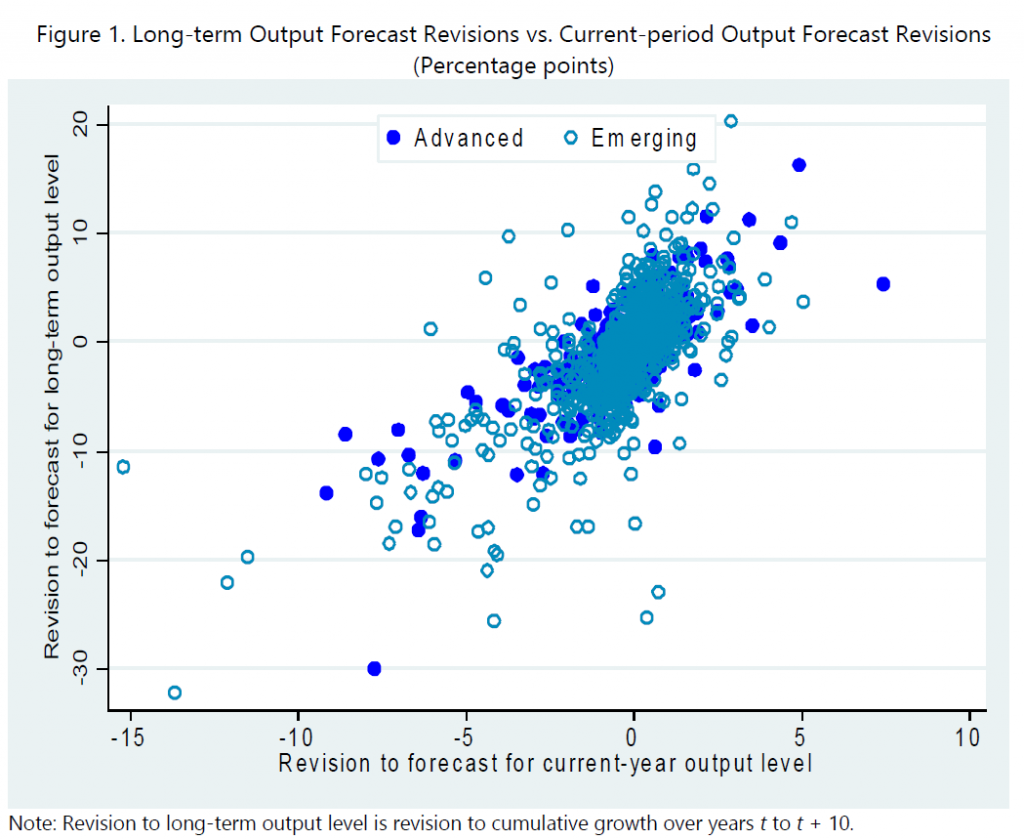Saturday, July 21, 2018
Is the Cycle the Trend? Evidence from the Views of International Forecasters
A new IMF working paper by John Bluedorn and Daniel Leigh revisits “the conventional view that output fluctuates around a stable trend by analyzing professional long-term forecasts for 38 advanced and emerging market economies. If transitory deviations around a trend dominate output fluctuations, then forecasters should not change their long-term output level forecasts following an unexpected change in current period output. By contrast, an analysis of Consensus Economics forecasts since 1989 suggest that output forecasts are super-persistent—an unexpected 1 percent upward revision in current period output typically translates into a revision of ten year-ahead forecasted output by about 2 percent in both advanced and emerging markets. Drawing upon evidence from the behavior of forecast errors, the persistence of actual output is typically weaker than forecasters expect, but still consistent with output shocks normally having large and permanent level effects.”
A new IMF working paper by John Bluedorn and Daniel Leigh revisits “the conventional view that output fluctuates around a stable trend by analyzing professional long-term forecasts for 38 advanced and emerging market economies. If transitory deviations around a trend dominate output fluctuations, then forecasters should not change their long-term output level forecasts following an unexpected change in current period output. By contrast, an analysis of Consensus Economics forecasts since 1989 suggest that output forecasts are super-persistent—an unexpected 1 percent upward revision in current period output typically translates into a revision of ten year-ahead forecasted output by about 2 percent in both advanced and emerging markets.
Posted by at 1:11 PM
Labels: Forecasting Forum
The Globalization of Farmland
A new IMF working paper by Rabah Arezki, Christian Bogmans, and Harris Selod provides “both theoretical and empirical evidence of farmland globalization whereby international investors directly acquire large tracts of agricultural land in other countries. A theoretical framework explains the geography of farmland acquisitions as a function of cross-country differences in technology, endowments, trade costs, and land governance. An empirical test of the model using global data on transnational deals shows that international farmland investments are on the aggregate likely motivated by re-exports to investor countries rather than to world markets. This contrasts with traditional foreign direct investment patterns where horizontal as opposed to vertical FDI dominates.”
A new IMF working paper by Rabah Arezki, Christian Bogmans, and Harris Selod provides “both theoretical and empirical evidence of farmland globalization whereby international investors directly acquire large tracts of agricultural land in other countries. A theoretical framework explains the geography of farmland acquisitions as a function of cross-country differences in technology, endowments, trade costs, and land governance. An empirical test of the model using global data on transnational deals shows that international farmland investments are on the aggregate likely motivated by re-exports to investor countries rather than to world markets.
Posted by at 1:05 PM
Labels: Inclusive Growth
Friday, July 20, 2018
Housing View – July 20, 2018
On cross-country:
- Fundamental Drivers of House Prices in Advanced Economies – IMF
- Despite the substantial guidance international law has provided, there has been a severe lack of progress for the right to housing around the world – UN Special Rapporteur on Right to Housing
- Does promoting homeownership always damage labour market performances? – IDEAS
On the US:
- Credit Supply and Housing Speculation – NBER
- CityLab University: Inclusionary Zoning – CityLab
- ‘A win-win’: Using local church buildings to address the affordable-housing crisis – Washington Post
- A Housing Paradox in Progressive Cities – New York Times
- Why the low-income housing tax credit matters for rural communities – Urban Institute
- California’s SB 375 and the Pursuit of Sustainable and Affordable Development – Terner Center
- Meet Jenny Schuetz, new Rubenstein fellow in the Metropolitan Policy Program – Brookings
- Maybe We Should Give Up On NIMBY Cities – Forbes
- Coastal Oregon’s properties under threat by rising tides – Financial Times
- Americans have not forgotten that house prices can fall – Capital Economics
- New Hotel or Affordable Housing? Race Is On to Define ‘Opportunity Zones’ – Wall Street Journal
- Big Builders Are Remodeling the Housing Market – Wall Street Journal
- These Tax Laws Are Holding Back California’s Housing Market – Bloomberg
- The Longest Economic and Housing Expansions in U.S. History – Calculated Risk
- Booming housing market today presents serious risk for future – American Enterprise Institute
- AEI: First-time homebuyers are still in the game – American Enterprise Institute
- The Blob: 1998-1999. Presented at: Should Fannie Mae and Freddie Mac be Shrinking or Expanding Their Activities? – American Enterprise Institute
On other countries:
- [Australia] Property auctions are Sydney’s newest sport – Economist
- [Australia] Going, going gone for Australia’s house price boom. And some investors smell trouble – Reuters
- [Canada] Vancouver’s One-Two Punch Is Expensive Homes and Low Wages – Bloomberg
- [Canada] C. real estate group says market balancing out amid new mortgage rules, lower demand – Globe and Mail
- [Canada] Bank Of Canada’s Stephen Poloz Suggests Buying A Smaller Home, After Hiking Interest Rates – Huffington Post
- [Canada] Ontario throne speech ignores housing affordability – Fraser Institute
- [China] The Effect of Real Estate Prices on Chinese Bank Performance – Federal Reserve Board
- [China] China housing price growth edges up in June – Financial Times
- [Chile] Alcaldesa de Peñalolén y viviendas sociales: “Aquí el prejuicio es la palabra clave” – CNN
- [Ireland] Ireland’s volatile property market shows fresh sign of a surge – Financial Times
- [Lithuania] Housing Price, Credit, and Output Cycles: How Domestic and External Shocks Impact Lithuania’s Credit – IMF
- [New Zealand] Mortgagor Vulnerability and Deposit Affordability in New Zealand before and after the Loan-to-Value Restrictions – Reserve Bank of New Zealand
- [United Kingdom] New rules on equity release ‘could raise mortgage prices’ – Financial Times
- [United Kingdom] Car dependence and housing affordability: An emerging social deprivation issue in London? – University College London
- [United Kingdom] Defying London’s House-Price Decline – Bloomberg
- [United Kingdom] No affordable homes? We’ll build them ourselves – BBC
Photo by Aliis Sinisalu
On cross-country:
- Fundamental Drivers of House Prices in Advanced Economies – IMF
- Despite the substantial guidance international law has provided, there has been a severe lack of progress for the right to housing around the world – UN Special Rapporteur on Right to Housing
- Does promoting homeownership always damage labour market performances? – IDEAS
On the US:
- Credit Supply and Housing Speculation – NBER
- CityLab University: Inclusionary Zoning – CityLab
- ‘A win-win’: Using local church buildings to address the affordable-housing crisis – Washington Post
- A Housing Paradox in Progressive Cities – New York Times
- Why the low-income housing tax credit matters for rural communities – Urban Institute
- California’s SB 375 and the Pursuit of Sustainable and Affordable Development – Terner Center
- Meet Jenny Schuetz,
Posted by at 5:00 AM
Labels: Global Housing Watch
Tuesday, July 17, 2018
Carbon Dioxide Emissions: Global and US
From Conversable Economist:
“US emissions of carbon have been falling, while nations in the Asia-Pacific region have already become the main contributors to the rise in atmospheric carbon dioxide. These and other conclusions are apparent from the BP Statistical Review of World Energy (June 2018), a useful annual compilation of global trends in energy production, consumption, and prices.
Here’s a table from the report on carbon emissions (I clipped out columns showing annual data for the years from 2008-2016). The report is careful to note: “The carbon emissions above reflect only those through consumption of oil, gas and coal for combustion related activities … This does not allow for any carbon that is sequestered, for other sources of carbon emissions, or for emissions of other greenhouse gases. Our data is therefore not comparable to official national emissions data.” But the data does show some central plot-lines in the carbon emissions story.”
From Conversable Economist:
“US emissions of carbon have been falling, while nations in the Asia-Pacific region have already become the main contributors to the rise in atmospheric carbon dioxide. These and other conclusions are apparent from the BP Statistical Review of World Energy (June 2018), a useful annual compilation of global trends in energy production, consumption, and prices.
Here’s a table from the report on carbon emissions (I clipped out columns showing annual data for the years from 2008-2016). Read the full article…
Posted by at 5:00 PM
Labels: Energy & Climate Change
A carbon tax would be less regressive than energy efficiency standards
From VOXEU:
“When it comes to solving externalities like pollution, efficiency standards are more popular than taxes. The rationale behind this is that the burden of taxes would fall disproportionately on the poor. This column argues that standards are in fact more regressive than taxes. Given their lower cost, the results suggest that tax solutions should be favoured over efficiency standards.”
From VOXEU:
“When it comes to solving externalities like pollution, efficiency standards are more popular than taxes. The rationale behind this is that the burden of taxes would fall disproportionately on the poor. This column argues that standards are in fact more regressive than taxes. Given their lower cost, the results suggest that tax solutions should be favoured over efficiency standards.”
Posted by at 4:57 PM
Labels: Energy & Climate Change
Subscribe to: Posts






